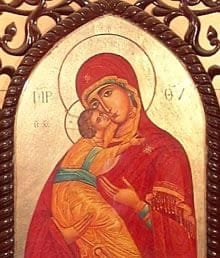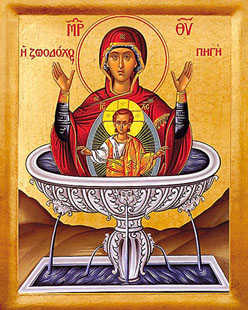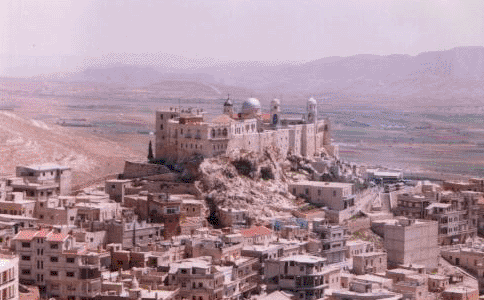Virgin Hodegetria

Roman legions may have marched under their Eagles, but for Byzantine armies and navies it was the icons of the Virgin Mary that inspired them. They took two main forms.
Hodegetria refers to icons of the Virgin Mary pointing to the Christ child (it literally means "She who shows the way" to salvation), as in the image above. It was named after an icon from the Hodegon Monastery in Constantinople that was one of a few precious icons said to have been painted by Saint Luke.
The other popular alternative was to show Jesus appearing on a medallion in front of Mary, her hands raised, as in the image below. The Incarnation. Both styles really took off only from the 10th and 11th centuries.

In the Eastern Orthodox faith, such icons ("images") do not "represent"; they are what they portray, so for pilgrims standing before these icons, it was (and is) common for them to experience Mary opening her arms to embrace them. Byzantine images are mostly intentionally flat and two-dimensional and in the early centuries actual figures were only rarely used. There were periodic outbreaks of Iconoclasm ("image-breaking") in the 8th and 9th centuries.
In the Catholic faith, representation is more realistic, allowing for three dimensional images. However, it does seem that Catholic pilgrims have a similar religious experience.
A similar divergence occurred in the images of Christ upon the cross, which was banned till 692 CE. If Christ was shown at all, it was only in the Catholic West, and he was shown as a lamb, not as a man. Perhaps crucifixion imagery was inherently depressing; perhaps it contradicted the desire by early Christians to see Jesus as divine. At any rate, only in the medieval period did crucifixion imagery gain preeminence in the West and never in the East.

Above is Saidnaya, a town in the mountains of Syria near Damascus, the seat of the ancient Patriarchate of Antioch, that was second only to Jerusalem as a place of pilgrimage in Byzantine times. Perched above the town is the Convent of Our Lady of Saidnaya, in which is the Icon of the All-Holy Virgin (or El Chagoura), which is said to be one of four painted by Saint Luke. That's it up top and it showed up late in the 8th century.
The Convent was built at the orders of Justinian in 547 AD on the site of where he had a vision of the Virgin Mary, first as a gazelle then as Mary herself in a blinding light. She later appeared to him in a dream to give him the architectural design for the convent. However it seems more likely Justinian had a fortress in mind.
